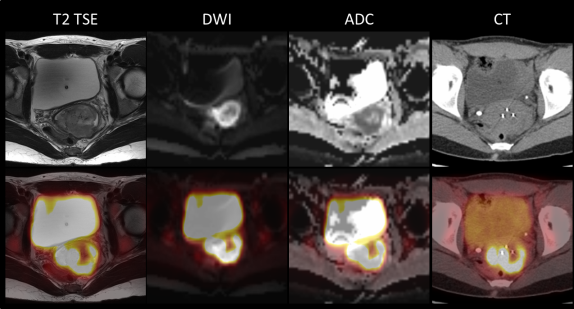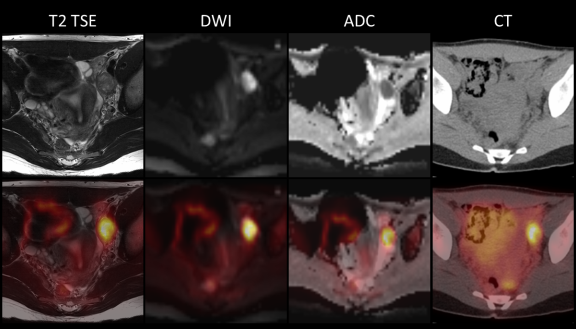Evaluating Hybrid PET/MR in Cervical Cancer Patients
Washington University’s Mallinckrodt Institute of Radiology is imaging cervical cancer patients with hybrid PET/MR. Here’s what they’ve learned about this new modality.
Washington University’s Mallinckrodt Institute of Radiology installed the Siemens Biograph mMR hybrid PET/MR unit in the fall of 2011 and has been evaluating this new technology in cancer patients. So far 18 cervical cancer patients have been imaged as part of an ongoing research study.
Diagnostic Imaging spoke with Jon McConathy, MD, PhD, assistant professor of radiology with a clinical practice in nuclear medicine, and Maria Thomas, MD, PhD, radiation oncology resident, about the university’s findings so far and the use of this hybrid modality in the future.
What is the alternative for evaluating patients and why have PET/MR as an option?
Thomas: Traditionally we obtain PET/CT for patients, both newly diagnosed and patients in follow up for cervical cancer. The PET/MR technology recently became available and the unit was recently installed here at Washington University. There are several reasons we are particularly interested in PET/MR as opposed to PET/CT. A major advantage of PET/MR is the synchronous acquisition of two important imaging modalities for cervical cancer, PET and MR. This avoids differences in patient position, bladder and rectal filling, and tumor growth.
Also, MR provides better soft tissue resolution in the pelvis than CT, and that’s very helpful in radiation treatment planning, as we use this imaging to guide our radiation treatment plan. We generally obtain diagnostic MR imaging for patients prior to starting their treatment, so if we were to transition to PET/MR it would reduce patient imaging time. Instead of obtaining a PET/CT and a diagnostic MRI they could potentially just have a PET/MR imaging study.
So this is something that can be used for diagnosis, treatment planning and follow up?
Thomas: In follow up we also obtain PET/CTs and diagnostic MRIs for patients after they have completed their definitive therapy. In cases where there are indeterminate findings on either the PET/CT or on the MRI studies, the ability to have the PET/MR synchronous acquisition will be helpful because we can more easily co-localize any abnormalities. That’s another potential advantage we see with the PET/MR.
What makes this use of PET/MR unique?
McConathy: There are a number of reasons this is exciting. PET/CT has become the workhorse of nuclear medicine imaging with PET. It’s not clear how much a role PET/MR will play in the near future but it looks like it will have advantages in certain cases like cervical cancer where having high quality, high contrast, high resolution images of a specific body region is important for radiation planning, or other cancers where surgical treatment might be the therapy of choice - but also having the high sensitivity and the ability to stage the whole body with the FDG PET. I think that’s one of the areas where PET/MR could play a big role, when a detailed evaluation of a specific body region or organ is very important but there is also need for whole body staging, and adding FDG PET to the MR can help detect metastases that might be missed otherwise.
In these patients getting radiation therapy, reduction of diagnostic imaging radiation is probably not a major consideration, but in others like children or young people, people with curable cancers, who are likely to get imaged repeatedly, PET/MR can provide a way to reduce the radiation dose by eliminating the CT component but not compromising on the diagnostic quality of the anatomic imaging. Those are two obvious areas where PET/MR could play a role in the near future.
New technology means there’s a learning curve. What has the implementation and use been like so far?
McConathy: From a diagnostic imaging point of view, it’s a challenge but overall a good challenge. Typically the body MR service and PET/CT service don’t interact on a daily basis. But now we need to discuss how we are going to do an exam everyone feels comfortable reading, everyone feels confident is at least as good as PET/CT. It has generated a lot of dialogue, mostly constructive, between people who do exclusively diagnostic radiology and people who do exclusively nuclear medicine.
One of the big challenges though for whole body PET/MR is that there is not a standard of care whole body MR oncology protocol. Unlike incorporating CT into PET/CT, you’re not simply bringing an existing CT whole body protocol on board. There’s a lot more protocol development for the whole body MR part of the study. That’s one of the big areas of emphasis we’ve been looking at, not only through this cervical cancer study but also though this institutional research study comparing FGD PET/CT to PET/MR.
The flipside of the challenges of this technology is that it opens up a lot of opportunities. Some of it is deciding which sequences are the most important, most valuable and most practical to do from a throughput standpoint and from the standpoint of the patient being able to tolerate being in the scanner for a long time.
What have you learned so far, and where do you go in the future based on what you’ve learned?
Thomas: The first objective was to confirm the imaging quality is at least similar between PET/CT and PET/MR and that we get similar interpretations. Thus far we see they are fairly comparable and PET/MR is giving us reliable information. We’ve compared basic information that we can obtain from the imaging studies.
One particular parameter is the SUVmax which measures the maximum uptake of the FDG within the tumor, and we have found so far that it is fairly comparable between PET/CT and PET/MR within about 10 percent. The metabolic tumor volume is another parameter we measure and that’s been also fairly similar between the two modalities, within 20 percent in the patients we have evaluated so far.
We have also looked at patients who are either obtaining imaging prior to therapy, patients who are having imaging during their definitive therapy and patients being followed after completion of their therapy. So far, the PET/CT and PET/MR have identified areas of disease that are generally in agreement. When we have two independent experts reading the scans, there are sometimes areas where a certain lymph node is indeterminate, and there may be disagreement as to whether there is disease there or not. There’s an early indication that there is a little more agreement with PET/MR but that’s preliminary.
McConathy: For future directions, I’m fairly confident based on our initial experiences that cervical cancer will be one of the major cancers we look at with PET/MR. Our goal is in the next few months to begin performing not only research but clinical studies with the PET/MR for patients that have either a standard of care need for FDG PET or a need for standard of care MR. A lot of the challenge now is getting the institutional pieces in place.
We will be doing this as part of a registry so patients who have a PET/MR study as a standard of care exam will be entered into a research registry so we can get some basic information about utilization and image quality. This registry will also provide a resource that over time we can use to perform analysis to find out where PET/MR is contributing most, what kind of cancers and what and what kind of patients are best suited for imaging with PET/MR.
Cervical cancer is an example of a cancer where the MR contributes for the assessment of local disease and of the primary tumor, and the PET helps detect additional regional and distant metastases. Other scenarios where you might have a similar paradigm would be head and neck cancer, where the primary tumor and lymph node staging are very important for deciding whether the patient should have surgery, if so what should be done, and what additional treatments are needed.
Another area where I think we will see a good number of patients is lymphoma, as many of these patients undergo repeated imaging with FDG PET/CT. We could reduce the radiation dose to these patients without compromising on the anatomic imaging component of the study.

Comparison of PET/MR and PET/CT imaging of a primary cervical cancer with markedly increased FDG uptake. On the top row, selected MR images from the PET/MR acquisition are shown with T2 turbo spin echo (T2 TSE), diffusion weighted imaging (DWI) and apparent diffusion coefficient (ADC) sequences. Additionally, a non-contrast CT image (CT) from the PET/CT acquisition is shown on the top row on the right. The MR images show superior soft tissue contrast and diffusion restriction (high signal on DWI, low signal on ADC) in the cervical cancer. The bottom row of images shows the fusion FDG-PET images from the PET/MR and PET/CT studies. The higher bladder activity observed in the PET/MR images is due to time interval between the initial PET/CT and the subsequent PET/MR acquisitions.

Comparison of PET/MR and PET/CT imaging of a left external iliac chain lymph node metastasis from cervical cancer with increased FDG uptake. On the top row, selected MR images from the PET/MR acquisition are shown with T2 turbo spin echo (T2 TSE), diffusion weighted imaging (DWI) and apparent diffusion coefficient (ADC) sequences. Additionally, a non-contrast CT image (CT) from the PET/CT acquisition is shown on the top row on the right. The MR images show superior soft tissue contrast and diffusion restriction (high signal on DWI, low signal on ADC) in this lymph node metastasis. The bottom row of images shows the fusion FDG-PET images from the PET/MR and PET/CT studies.
Images courtesy Washington University’s Mallinckrodt Institute of Radiology
Emerging AI Algorithm Shows Promise for Abbreviated Breast MRI in Multicenter Study
April 25th 2025An artificial intelligence algorithm for dynamic contrast-enhanced breast MRI offered a 93.9 percent AUC for breast cancer detection, and a 92.3 percent sensitivity in BI-RADS 3 cases, according to new research presented at the Society for Breast Imaging (SBI) conference.
Could AI-Powered Abbreviated MRI Reinvent Detection for Structural Abnormalities of the Knee?
April 24th 2025Employing deep learning image reconstruction, parallel imaging and multi-slice acceleration in a sub-five-minute 3T knee MRI, researchers noted 100 percent sensitivity and 99 percent specificity for anterior cruciate ligament (ACL) tears.
New bpMRI Study Suggests AI Offers Comparable Results to Radiologists for PCa Detection
April 15th 2025Demonstrating no significant difference with radiologist detection of clinically significant prostate cancer (csPCa), a biparametric MRI-based AI model provided an 88.4 percent sensitivity rate in a recent study.